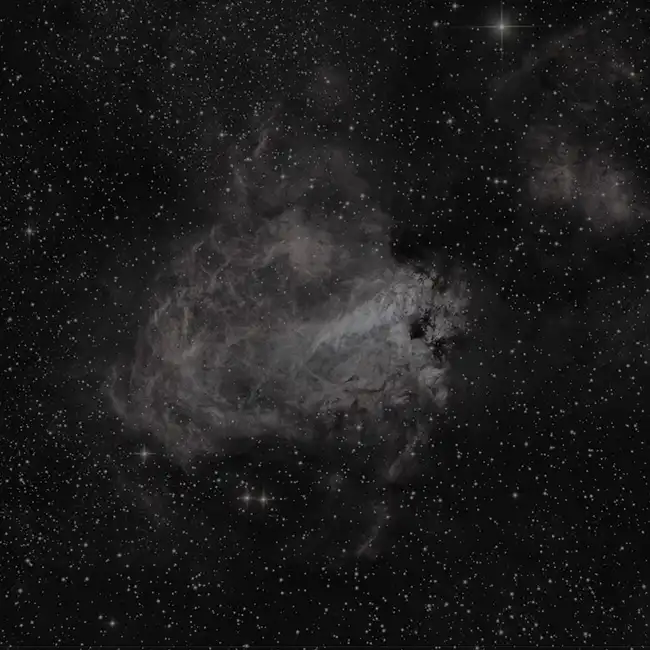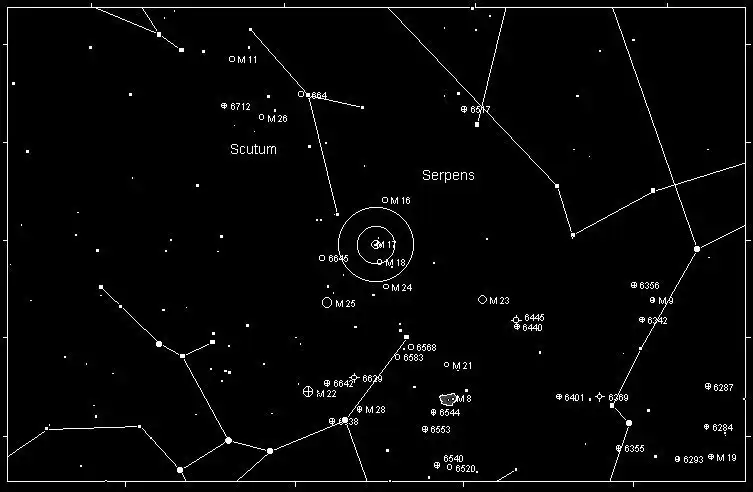Messier 17 (M17), commonly known as the Omega Nebula, Swan Nebula, or Horseshoe Nebula, is one of the most beautiful star-forming regions in the Milky Way. Located in the constellation Sagittarius, this emission nebula is a vast cloud of gas and dust, home to young, hot stars that emit intense ultraviolet light, causing the surrounding gas to glow brightly. M17's glowing gases create stunning shapes that resemble swans, horseshoes, or even the Greek letter Omega (Ω), depending on your perspective.
The Omega Nebula spans about 15 light-years across and lies approximately 5,000 to 6,000 light-years away from Earth. It is part of a larger molecular cloud that is a major stellar nursery, producing new stars at a rapid pace. M17 is one of the brightest and most massive star-forminMagnitude
Messier 17 has an apparent magnitude of around +6.0, making it visible to the naked eye under ideal dark-sky conditions. However, in most cases, binoculars or a small telescope will reveal the nebula’s structure and brightness. Larger telescopes will bring out intricate details, such as the delicate filaments and knots of glowing gas that make this nebula a fascinating target for amateur astronomers.g regions in our galaxy.

Prominence by Season
The Omega Nebula is best observed during the summer months in the Northern Hemisphere, particularly from June to August. Sagittarius, the constellation in which it resides, is high in the sky during this season, making M17 an ideal summer target. The nebula is located near the core of the Milky Way, so observing it in summer nights under dark skies will also reward you with a rich background of stars.
Constellation and Location
Messier 17 is located in the constellation Sagittarius, which is known for its rich collection of deep-sky objects due to its location near the galactic center. Sagittarius is also home to the famous Lagoon Nebula (M8), the Trifid Nebula (M20), and many star clusters, making it a treasure trove for astronomers.
To find Messier 17, first locate the Sagittarius constellation, which resembles a teapot shape. The nebula is situated just north of the "spout" of the teapot. More precisely, M17 lies about 2.5 degrees north of the star Mu Sagittarii. You can also look for the nearby bright star cluster M16, the Eagle Nebula, as M17 is only a few degrees away from this iconic neighbor.
How to Find M17
To observe M17 with a telescope, begin by aiming towards the Sagittarius constellation. Use a low-power eyepiece to locate the general area of the nebula, near Mu Sagittarii. Once you have it in your field of view, you can switch to a higher magnification to reveal more detail in the nebula's structure. A UHC (Ultra High Contrast) filter or an O-III filter can help enhance the view of the nebula's glowing gas by filtering out light pollution and increasing contrast.
Even small telescopes will reveal the swan-like shape of the nebula, while larger telescopes will bring out the finer details. The region is rich with stars, so taking the time to scan the surroundings will also uncover many other interesting objects in this stellar nursery.

History
Messier 17 was discovered by the Swiss astronomer Jean-Philippe Loys de Chéseaux in 1745-46. However, it was Charles Messier who independently rediscovered it on June 3, 1764, and added it to his famous catalog of nebulae and star clusters. Messier described the nebula as a "cluster of small stars" with a faint glow surrounding them, though modern telescopes have revealed it to be much more complex and dynamic than early observers could have imagined.
M17 has been studied extensively by professional astronomers using both ground-based telescopes and space observatories. It is an important region for understanding the process of star formation, as it is one of the most massive star-forming regions within our galaxy. Studies of M17 have provided valuable insights into how stars and planetary systems like our own solar system form from clouds of gas and dust.
Conclusion
Messier 17, the Omega Nebula, is one of the most captivating objects in the night sky. Its beauty and the wealth of scientific information it provides make it a favorite target for both amateur and professional astronomers. Observing this nebula offers a glimpse into the dynamic processes of star formation, and its prominence in the summer sky makes it an ideal object to explore during warm, clear nights.
